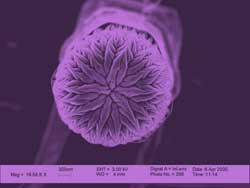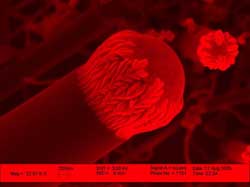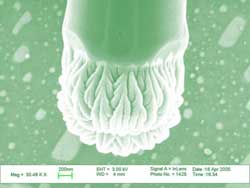Becky Thompson
Imagine starting a new internship, first week on the job and you don't know a soul. But you're curious. How did these people get here? What are they like? Where do they come from? Do they have any cool body piercings?
Luckily, instead of spending months getting to know my co-worker Becky, I got to sit down with her and blatantly ask her lots of fun life questions. And she's got a cool tongue piercing.
Becky Thompson’s interest in science, like most things in her life, came about randomly. Sitting on the bus one day in high school, a classmate suggested that Becky would probably like the physics class she was taking, and that Becky should take it too. Not needing any further persuasion, Becky signed up and was hooked. Continuing on to Bryn Mawr College in PA, "I knew that I liked learning, and I knew that I liked science, but I didn't really know what to do about it," she says. Her quest for an intellectual challenge made physics an attractive option.
Born in Chicago to a physicist father and high school principal mother, Becky grew up near Annapolis MD. As a child, she was somewhat of a walking disaster, getting into scraps, always covered in bruises. "But remarkably, I've never broken a bone," she laughs. She was also a little nerdy. "The band made fun of me."
After completing her BA in physics from Bryn Mawr, Becky headed south to the University of Texas at Austin, where she received her PhD under Michael Marder at the Center for Nonlinear Dynamics. A combination of floral art and physics, her research involved analyzing the elaborate buckling patterns naturally found in daffodils. Crumble of a piece of paper and you get wrinkling, a distinct pattern made up of sharp peaks. "Buckling is kind of like wrinkling, except you get more curved patterns," explains Becky. After computationally creating a triangular net of mass points representing the buckling patterns of the flower, Becky put them into a fourth spatial dimension by adding one variable to all the calculations. "Visualizing it was a bit trickier," she says.
She also analyzed nanoflower patterns. Nanoflowers aren’t real flowers of course, but can be grown in the lab using the same starting materials- a "seed" and "nutrients". In this case, the "seed" is the tip of a silicon nanowire, and the "nutrients" are combinations of different gases. Instead of gardening, Becky's nanoflowers were grown by her colleagues Joonho Bae and Ken Shih, using a specific vapor-liquid-solid method.
As nanoflowers grow, tiny intricate patterns of silicon oxide form clusters on the wire. None of this can be seen by the naked eye; these beauties are about a thousand times thinner than one strand of human hair. In order for a nanoflower to form, the nanowire itself has to grow, kind of like the growth of a stem before the blossoming of a flower. The more the silicon grows the more complex the flower pattern will be. Becky's research shows that nanowires grow in the presence of gold, which acts as a catalyst to speed up the reaction required for growth. Gold is actually pretty important, you can use the same process to create nanoflowers without gold,but you won't get any cool looking patterns.
In her analysis of nanoflower patterns, Becky found that the inner core of the flowers are composed of gold, silicon, and oxygen. This particular composition suggests that oxidation, the exposure of elements to oxygen, is crucial for nanoflower formation. The flowering pattern exhibits a specific type of dense branching often seen in bacteria growth and liquid crystals. This is the first time that dense branching has been found in such a small length scale.
When she wasn't researching stunningly complex nano-creations, Becky traveled around Austin to local schools as her alter ego: a one woman physics show. After blowing stuff up, making pickles glow, and smashing glass, she'd leave young minds full of excitement, in awe at the destruction and weirdness science is capable of. Becky knew she didn't want to teach, but loved what she was doing. Solution? Break into the field of physics outreach! After a chance encounter and some good luck, she now gets to design fun experiments, play with toys, and get paid for it as Head of Public Outreach for APS.
When she's not doing awesome physics outreach work, Becky whizzes by on bicycles, swims, and runs in various triathlons, while somehow finding the energy to train up to 6 days a week.
















